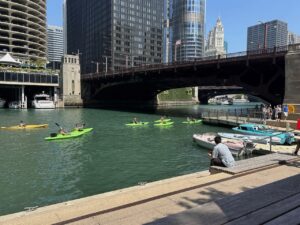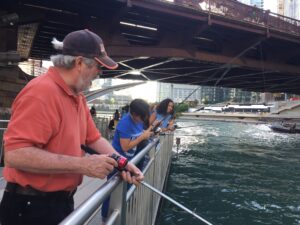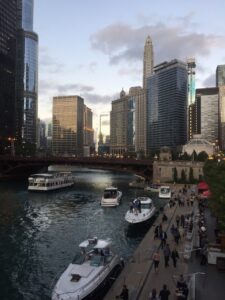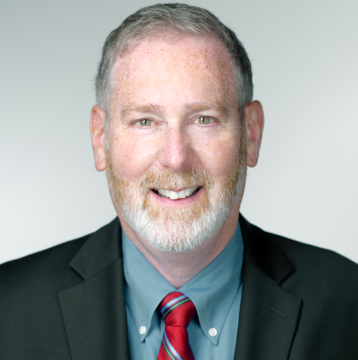Chicago River
April 08, 2024
Swimming in the Chicago River: Advocacy Helped Make This Happen
As Chicago plans for a historic open swim in the river, ELPC reflects on the work it took to clean up the river
An open-water swim in the Chicago River is coming up in September! Here’s an example of successful environmental legal and public advocacy making a real difference for safe, clean water for all. Let me tell you a story.
Stuck in the Mud
More than 15 years ago, the Environmental Law & Policy Center, Friends of the Chicago River, Sierra Club, NRDC and partners challenged the Metropolitan Water Reclamation District of Greater Chicago’s (MWRD) to clean up the river. MWRD was refusing to install modern pollution control equipment to disinfect its wastewater into the iconic Chicago River. For years, Chicagoans tolerated their namesake river being unsafe and unhealthy for recreation and enjoyment. Chicago was one of the very few major cities in which wastewater was not disinfected prior to discharge into the river.

Kayaking on the river, 2024
The MWRD President at the time, Terrance O’Brien, was simply stuck in the mud. He was strongly opposed to spending money on widely available treatment technology to disinfect sewage dumped from MWRD’s North Side and Calumet water treatment plants. Effluent from the plants, which is full of bacteria and pathogens from sewage, makes up 70% of the water in our waterways, which includes the Calumet system.
President O’Brien kept banging away at the supposed cost to taxpayers. ELPC and our colleagues viewed disinfection as a solid investment in a cleaner, healthier river system for the Chicago area that would pay off in environmental and economic improvements for the future.
As it has.
Take a walk on Chicago’s Riverwalk in the summer, teeming with people dining at the cafes, running, fishing and enjoying the riverfront with friends. Take a look at the people in the tourist boats, kayaks and canoes enjoying their time on the Chicago River.
Progress didn’t come easy
After six years of persistent and effective strategic litigation and public advocacy by ELPC and our valued partners, we succeeded in June 2011.
The Illinois Pollution Control Board, which had been the venue for a precedential litigation and science-policy debate over disinfection, issued a proposed decision that largely reinforced the policies and directions put forth by the U.S. EPA and our environmental coalition. The Pollution Control Board directed MWRD to install modern pollution control equipment to disinfect wastewater.

ELPC fishing event on the Chicago River, in partnership with the Chicago Park District and Friends of the Chicago River in 2019
Many of our leading public officials stepped up their persuasion and pressure on the MWRD clean up its act. Kudos to the U.S. Senators Dick Durbin and Mark Kirk, Congressman Mike Quigley, Governor Pat Quinn, Illinois Attorney General Lisa Madigan, and members of the Chicago City Council who publicly advocated for disinfecting and cleaning up the Chicago River.
Special appreciation to U.S. Senator Dick Durbin for his leadership. In one special moment, Senator Durbin held a packed-room public hearing at which MWRD senior representatives testified and responded to questions. Senator Durbin asked then-US EPA Region 5 Administrator Susan Hedman and me to advise him on this issue. We sat on each side of Senator Durbin while he fairly, pointedly and effectively asked the chagrined MWRD staff to please explain why MWRD couldn’t act to disinfect their wastewater just as 30 other major cities were doing. Senator Durbin was masterful. Hats off to Senator Durbin. Check out his June 7, 2011 press statement here.
The MWRD voted on June 7, 2011 to do the right thing. They finally ended the practice of dumping only partially treated sewage into local waterways. The many coalition partners celebrated together. Here’s what I said then:
“On this hot summer day, the Chicago River is becoming cooler, healthier, safer and a better community asset for all of us to enjoy. We’re on our way toward a Chicago River that will be safer for paddling, fishing, recreation and development.”
Indeed, we are. The public and the river’s aquatic ecosystem are reaping the benefits today.
A Clean River is a Powerful Civic Asset

Enjoying sunset on the Chicago Riverwalk
Since then, the Chicago River’s public use and enjoyment has soared. From the new boat houses in Roscoe Village and Chinatown, to the flourishing Riverwalk downtown, Chicagoans and tourists have come to embrace the River as an asset rather than a smelly eyesore. The Chicago Riverwalk generates business revenue as folks have fun.
We’re proud — no kidding! It’s great to see this happening as I look outside from ELPC’s Chicago office windows overlooking the Chicago River. Shout out to Margaret Frisbie and her team at Friends of the Chicago River for all that they’re doing each day to help make our River cleaner and better for all.
This Chicago River clean up took too long to happen, and we need to keep on working to make it better. That said, let’s recognize the progress we’ve achieved.
So, let’s celebrate together at the big swim in the Chicago River in September. Please let me know if you’d like to join the ELPC team at this event. Bravo all!


